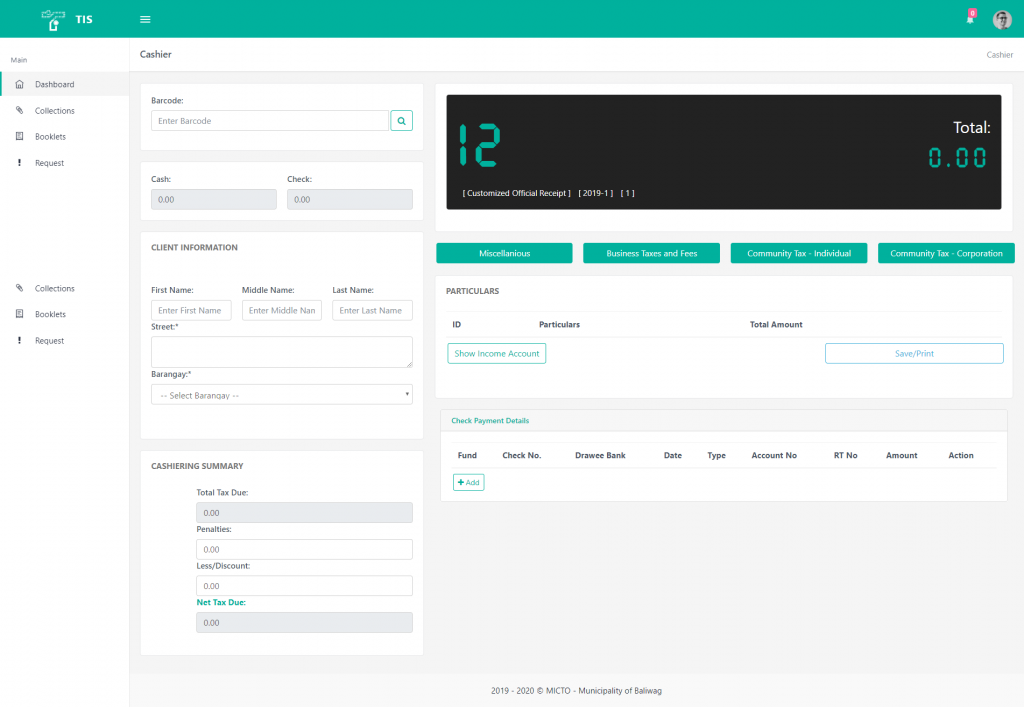Name of the Organization
Municipal Government of Baliwag, Bulacan
Name of the Office/Unit that leads the implementation of this best practice entry
Municipal ICT Office of Baliwag (MICTO)
Focus Area of the Best Practice
Municipal Treasury Office/Citizens – ICT/Operations Management
Summary of the Best Practice
To help ensure efficiency and integrity in handling payment transactions and accounts, the Local Government of Baliwag, in partnership with the Landbank of the Philippines, developed the Treasury Information and Management System (TIMS). TIMS is a web-based, centralized platform that helps in reducing the risks that come with manual data submissions. The system has been instrumental in promoting transparent and efficient financial reporting.
TIMS is also a scalable system that allows the creation of more accounts and integration into other related local government systems. It is also economical as it cuts the costs spend on papers and supplies while helping avoid data alterations and repetitions.
The system is cloud-based and powered through a dedicated server with SSL (Secure Sockets Layer) to ensure that all data passed between the web server and browsers remain protected. The data are being backed-up daily through an in-house server located in the server room of the MICTO.
Challenges
Prior to the TIMS, the municipal offices in Baliwag had their data-gathering process. However, some steps had to be streamlined in order to seal possible loopholes for corruption, including transactions that were still being manually processed which were also prone to human errors and alterations.
In addition, data ownership or overprotection, which used to be common among other offices, has long blocked the opportunity to establish systems that can help minimize the time consumed in processing payments, as well as in generating reports. The lack of an established system compels these offices to create bureaucratic processes that sometimes slow down the work, which affects the timely delivery of programs to the people.
Given these problems, the Municipal ICT Office started selling the idea to the direct end-users—the local treasury department and its internal customers involved in designing, validating, and using the system. They were consulted to ensure that the TIMS addresses their reservations in shifting to an automated system and to guarantee that security risks and errors are reduced when they use TIMS.
The TIMS proponents also held orientation sessions to help the intended users learn how the system works.
Specifically, these were the steps conducted in developing and implementing the TIMS:
- Conceptualization. The project was conceived after gathering common problems and complaints in frontline offices from the inter-office planning sessions.
- Planning. The development of initial systems, system integration, and budgeting were included in the Information Systems Strategic Plan of the municipal government.
- Data gathering. Consultations and coordination meetings were held to gather preliminary requirements for the system. This also became a venue for stakeholders to give their expectations on the system.
- Purchase of tools. Cloud storage has been pre-purchased along with other cloud storage requirements for the other systems. Partnerships were also maximized to avail of other requirements for the system.
- Development & Learning. The MICTO developed the integrated system, along with occasional learning sessions to improve the modules.
- Proofing. Consultations and coordination meetings with key stakeholders served as a venue to initially present the system, gather more data, and monitor initial feedback to improve the user interface, user experience, and productivity.
- Roll-out. Demonstrations, orientations, and briefings on data protection and privacy started immediately after the system development.
- Next steps. The system remains a work in progress. More functions and accounts are to be integrated, and continuous updates of information and the development of reports can be expected.

Solutions and Impact
TIMS helps in promoting efficiency as it helped the Treasury Department of the Municipal Government of Baliwag to have streamlined and automated transactions. By providing a platform for financial data processing and protection, it opened opportunities for internal clients to save time and serve more people.
Manual paperwork has been minimized, if not eliminated, in offices that transact with the Treasury Department. With TIMS, the local government unit managed to avoid red tape, errors, and other risks posed by manual input and transmission order of payments.
Also, the system allows real-time monitoring of cash flow, therefore enabling local managers to act on targets and scale efforts as the need arises.
The fast and efficient report generation of TIMS also paved the way for faster evaluation of financial situations, enabling the finance cluster to come up with a better budget and income-generating plan.
To ensure sustained use of the TIMS, its development and maintenance were included in the targets of the MICTO and its personnel involved in BIPS development. Stakeholders were given web access for them to use the system, share data, and ensure that modules remain relevant to the people by providing insights from time to time.
